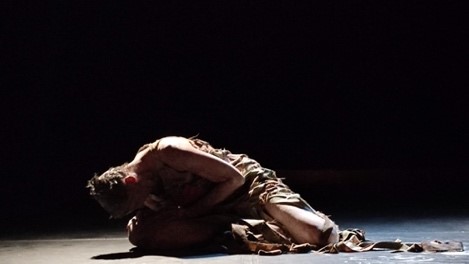ABJECT ~ An Irreducible Humanity 2023 - 2024
~ acknowledging performativity as witnessed devastation

You may also find that my various approaches to the thinking dancer have contradictory knowledge bases. However, I accommodate a plethora of philosophical viewpoints and even world views that may on some level contradict each other, yet in the dance they are all entangled as a way of being and understanding the materiality that I propose.
1. How did you decide that the abject1 was your inspiration to perform?
ABJECT is a stream of therapeutic, training and performance work undergirding performances with other artists such as musicians, or as solo performance. It is a vehicle with a particular methodology as epistemology that responds to an increasingly front-of-mind concern for the world we live in, and all and everything belonging to it.
The abject is a term I came across first when I was a BA Honneurs in Gender Studies student at UNISA during the years 1998-2001. We were the first cohort of the unit aiming to investigate Gender Studies from a multi-disciplinary perspective.
But first, a more personal account of the abject. After having gone through a rapid adjustment of pregnancy in 1993 as best I could get to grips with a cross-race relationship with a freedom fighter and former political prisoner, how I would situate myself in the still loaded Apartheid society and adjusting to major changes in my dancer’s body, our son was born. It was here that I experienced the complexities of being a mother in a society that was not geared to accommodate the full spectrum of the phenomenal responsibility of motherhood, in an existentially hostile and cold environment for this task to be executed.
Five years later I dug my heels in and made my way to UNISA to learn what was actually perturbing me in a role that I thought was honourable, inspiring, endeavoring to learn from as best I could, and under all circumstances. I was striving to do the best I could under the condition of one generic force: I was a thinking mother entangled in the patriarchy. Once I started to discuss, read and write my own condition into this task, I empowered myself to embody motherhood differently.
The theory opened up many avenues into not only motherhood, but a plurality of the phenomenon of parenthood that I was psycho-spiritually unaware of. Amongst other writers, French philosopher, avant-gardist, psycho-analyst and mother, Julia Kristeva, wrote extensively about motherhood in the manner in which I gravitated to. It was an existentialist approach in which she had articulated concepts that I had experienced on a psychological, affective, physical and spiritual scale. She elucidated what I subconsciously felt as a crisis of self-comprehension while I tried my best to make sense of a deeply transformative event in my life namely, motherhood.
One of Kristeva’s terms was the abject. She explained it as that which repulsed, revolted; a repugnance, disgrace that could literally make you sick. Abject is also defilement, sin, filth, pollution, everything to be scared of, suffering and horror, incompetency and unwillingness, corruption and internal wars with the seduction of consumerism. In fact, the abject, once realised as a bodymind phenomenon, is a mostly visceral protest against conforming to the social and ecological constructions of the paternal and the Law, therefore everything. It is only this Law that will convince you of your purity, and it is the same Law that will capitalize on your illusionary naivety, or “peace”, convincing you that the abject does not have the power to make you sick. As a result of Kristeva’s articulation, my motherhood slipped into a place of understanding the role so that I could act upon my impulses with greater autonomy, with clearer boundaries, and with lesser illusion that being a mother means that you have to do “the impossible inside while powerless outside,” one of Kristeva’s banner quotes.
Having access to the abject through art, writing, performance or philosophy, bodymind practices through dance and sexuality, mind-altering practices and many more evolving techniques, your bodymind realises it lives in the lie of irreconcilable illusions. Your being in the world is constantly dabbling in the consumerism of a becoming that you cannot be. The only way out as a performer is to recognize the looming, the imminent presence of the abject. The self in dissatisfaction and even disgust of the self, is the abject. Genre2 performance, my methodology, is a process in being-becoming, learning about, studying the abject. Can you see, or better still feel the abject? The performance, ABJECT ~ An Irreducible Humanity is about finding and forwarding the abject as part of the imminent love that performativity affords us to embody that which is most abhorrent to the human psyche. Once this field is entered the sense of being human becomes irreducible.
This theatrical iteration of ABJECT began in 2023. Many perturbing events were churning in the world. I was most concerned about a fast escalation of political mayhem in South Africa, a World War – pockmarked globally – was perpetually being born, climate realities plunged into existence and I could see the collapse of a civil ethic around me. Gradually abject became an embodiment of the effect of the patriarchate on the being of all and everything around me. As abject became a workable knowledge, I went back to Kristeva and re-read her, as well as my notes of 24 years ago. The performance – conceptualization, writing, costuming, repertoire of growing affect, movement vocabulary and relationality of support – grew in volume and significance each time I embodied it as a Genre methodology, and my title ABJECT ~ An Irreducible Humanity grew on me.
Humanity’s abjection – the wretchedness of our ruin – is growing. It is irreducible because our health and wealth as people lie in our ability and willingness to acknowledge our despair and devastation, become it, and feel the warmth and light of that conscious and intelligible agency.
As such, I explored how I would be able to prepare myself for a performativity of exponential abject – a gothic mediascape of dubious truths at every click, state-based violence, colossal climate upheavals, disappearing species ... in short, a world-wipe-out at the hands of some ... that made me sick. It was as if the abject that initially surrounded motherhood, was truly coming into universal focus. I could only truly reach into abjection intellectually, physically, emotionally, ontologically, ecologically, and ethically if I was prepared to dive into humanity, and, the more-than humanity – “the big picture” – as creation, as thinking dance performer.
1. Abject has been given many meanings. One, is the human reaction (ie horror, vomit) to a threatened breakdown in meaning caused by the loss of distinction between subject and object or between self and other.
2. I am often asked which genre of dance form I practice, and because I cannot put my finger on it, I call it Genre. This is largely because what I offer is the full humanity of the dancer which includes movement, voice, text and emotions. The full expression of this state of being should not have delimitations to the being of the dancer.
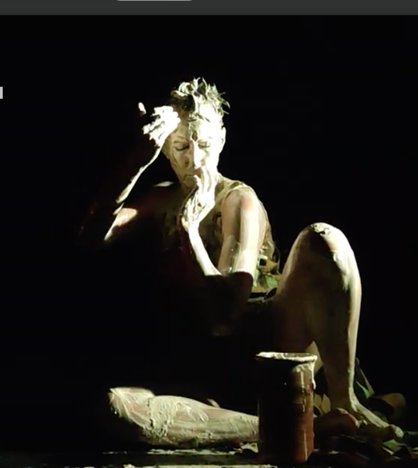

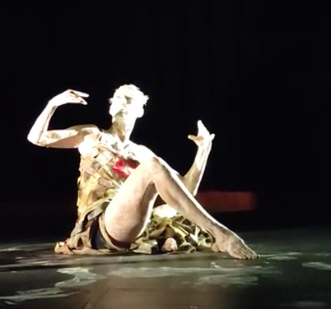
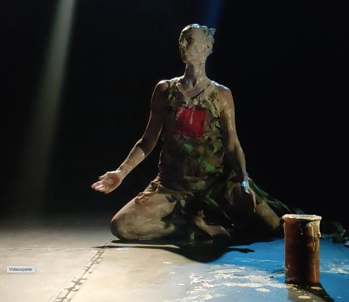
2. What is your physical and technical preparation for the performances?
The role of technique in dance has been embedded in my bodymind since the age of four when I stepped into my first ballet class. Before then, I have distinct memories of how I had moved as a young child. Whichever movement modality I now expose myself to, I am always curious about the technique being taught, the manner in which the human body is being seen as messenger of soul and spirit, and how much the technique has decolonized itself from dominating perspectives on humanity at large.3 These ideas were not present earlier in my dance career. They came with time, embodied experience and with age. I respect the learning process around embodiment and have a progressively more succinct purpose for why I train and move – and teach ¬– in particular ways.
I find myself on the floor (a banner quote for being in practice as a dancer) each day in one modality or the other. My main focus is the amalgamation of thought-and-movement, bodymind. This is a complex and considered process of training myself to be awake and alive in bodymind. The methodology is open-ended and exponential and includes for instance the origin and exit of a movement, imaginary accompaniment for movement, spatial and temporal considerations, principles of gravity, voice producing movement, text based dance, and so forth.
As breath accompanies movement always, voice, mostly movement of expelled air through audibility is an essentially free agent. Every movement is a potential breath, and vice versa. In Genre, we find this voice of movement by allowing this faculty to be open and available, uninhibited, fearless, tracing memories and visions, and being-and-becoming the partner of affective conditions.4
Amongst various modalities, I work with other dancers’ bodies. The latter involves a practice called Contact Improvisation. I learn from third-generation international teachers in this field. Besides the benefit of learning how other bodies move and feel against my own, this technique is an organic neurological re-configuration towards the integrated health spectrum of the human bodymind. As a movement therapist I am profoundly touched by specifically the mental health benefits of this technique. See the culmination of these at Music-Dance 2023 and earlier archival placements.
Steve Paxton, the originator of Contact Improvisation
I am aware of the history of the human body through the industrial age, slavery, separation from itself as spiritual entity and division of the self that promotes a “look” versus an “intelligibility”. Interrogating modalities of unexamined mechanization and pathologisation is crucial in studying movement for the future of the body.
My own work on the floor is generally an alignment with the energetics of movement, physical alignment for functionality, and the spacetimemattering5 that one gains from being a mover on and with the floor. It is vital that one softens movement through imagery. A way of seeing a movement and following its image through to its end is a training that supports the whole human being of the dancer and the life forces which could be said is the architect of the body. One wants to dance, to dance forever. Consider the body in space, in time and as evolutionary matter of the individual through the will and thinking. For the thinking dancer everything is connected. It is the dancer’s privilege to embody the self as an exercise in self-comprehension and each entry onto the floor with as much of one’s body touching the floor is a furthering of this purpose.
In preparing to perform, all these practices are being streamlined and reigned to serve the greater purpose of movement for the performance field. It mediates fundamental dualities (subject-object, mind-body, nature-culture, doing-being, environment-society, self-other, human and non-human matter), and investigates the hierarchising of humans as above nature on the “great divide” of modernity. This notion is inherent to the relics of the split bodymind. My research difficultates (reverting from easy solutions and conclusions) the principle that the body is both “the original object upon which the work of culture is carried out, and the original tool with which that work is achieved. It is at once an object of technique, a technical means, and the subjective origin of technique.”6
Quite incidentally, but crucial to this question of how a dancer trains, when the object and subject are no longer distinguishable, abject is being born from human ambivalence towards this collapsed-binary-crisis. From here, (with a random gesture) we can reference two conscious spaces in human existence: potential meaninglessness; and/or, a courageous exploration of the abject plight of humanity under conditions dawning upon us through, for instance, climate disasters – a different “meaninglessness” that brings an entirely different escalation of possibilities, agency and spirituality for humanity. ABJECT, the performance explores the latter.
Technique is a considered and intuitive alignment with my bodymind towards a goal not only to serve my dance but inclusive of the effects of my dance on the witnesses attending the events.
3. A colleague Dr Kristina Johnstone’s distinguished doctoral dissertation on the interrogation of representationalism in dance performance is a valuable source here. Pathways towards embodied technique: Disrupting representationalism in South African embodied dance praxis. University of Witwatersrand. 2022. https://hdl.handle.net/10539/34301
4. For more on the affect see Brian Massumi Politics of Affect 2015 Polity Press.
5. A term by feminist quantum physicist Karen Barad in Meeting the Universe Halfway. Quantum Physics and the Entanglement of Matter and Meaning. 2007. Duke University. “Space, time, and matter are intra-actively produced in the ongoing differential articulation of the world. Time is not a succession of evenly spaced intervals available as a referent for all bodies and space is not a collection of pre-existing points set out as a container for matter to inhabit. Intra-actions are nonarbitrary non¬-deterministic causal enactments through which matter-in-the-process-of¬ becoming is iteratively enfolded into its ongoing differential materialization...” p 234.
6. Spatz, Ben. Blue Sky Body. Taylor and Francis. Kindle Edition. p. 71

3. Your other practices include reading, writing and process art . How do you apply this to a performance such as ABJECT?
In my preparation for a performance there is an intensification of my creative reading, writing and process art practices. Since I perform to constantly re-configure and re-conceptualise myself in-and-as context for technique and embodiment, it requires that I study the field of my themes.
My reading for ABJECT has been wide, to include the interrogation of assumptions regarding the future of the human being within a world that appears to suffer tremendously under geo-political strife, neo-colonial strategies of destructivity and abuse of land, water, air spaces, soil and seas. I understand that the global turmoil is a major tumultuous and unpredictable event. What emerges wakes us up to centuries’ old illusions and perhaps potential for a future unrecognisable life in which the human may not look the same as today or may not even be the same entity we had known. This creates massive disturbance in the human psyche. I inform myself about these possibilities.
I attend reading groups spanning philosophy, psychology and spirituality, as I am curious about how humanity experiences the evolution of the soul and its spiritual quest on this planet.
While in the generally perturbing and restless process of constructing a performance, reading or writing run randomly adjacent to the organicity7 of the field I embody. Further, the symbol of the word – writing – collapses intermittently in the unfolding of an incessantly dubious entity such as abject. Then I do very simple artistic practices, either with pastels, paint, pencil or clay. One could imagine it being a movement exercise for which I produce a visual representation at the end of it. This is often revealing of my condition and understanding in ways that I would not have been aware of without art. I often display this for my viewing and sustain a meditation on these products supplementing my quest for deeper encounters with the phenomenon I investigate.
During ABJECT I experienced, amongst others, a particular movement vocabulary in rehearsals and in making my costume. For instance, for one, I was aware of being brusque, with a kind of jettisoning of my gestures and acts. Or I felt pre-linguistic in a movement sense, not with a dedicated coordination and focus, but with a bear-like lugging of myself around on the floor, patterning white clay on the floor and getting entangled in my costume. I replicated this movement on paper with paint – wet on wet – not with a brush but with my bare hands. The result of this was a large series of paintings that started off as a “woolly ball”, that of the first kind of paintings of the infant. Since it was without particular differentiation and other artistic consideration, I had found a particular “pleasure”8 in the making, and in the viewing afterwards. It was only towards the end of the rehearsal period that these paintings became varied in colour and formation. But I remained skeptical of creating “beauty” rather than an expression of authenticity.
My writing from the beginning of ABJECT was in this Q&A form. I loved it and wrote copious Q&As on various documents for different purposes. It was a creative genre of Genre, writing about my work and in which I could find an outlet for my thoughts, in a conversation. It was a process that sparked even more thoughts on the world. I am rewarded by the perpetuated and pursued depth of my will into these practices.
Writing is not meant to provide a linear configuration to my work. On the contrary, what happened in my limbs and torso as movement, and feelings and sensation during the process of rehearsal, find a “birthing” into an articulated complexity that satisfied me, yet again, on a feeling level. This way I can say that my reading of my writing is also not linear. After all, when we read our eye jumps all over the place, not to speak of how the brain re-organises itself to cope with a thought about something that is essentially metaphysical, almost like a different, thick present.
7. I assume that humans and non-humans are self-organising systems, with natural impulses towards growth and change.
8. Julia Kristeva would refer to this “pleasure” as jouissance. This term is expansive and includes the pleasure of pain, something that mothers may recognise as a confluence between the pain of mothering yet the pleasure to mother at the same time. See Kristeva’s seminal book Powers of Horror. An Essay on Abjection. 1982. Columbia University Press.

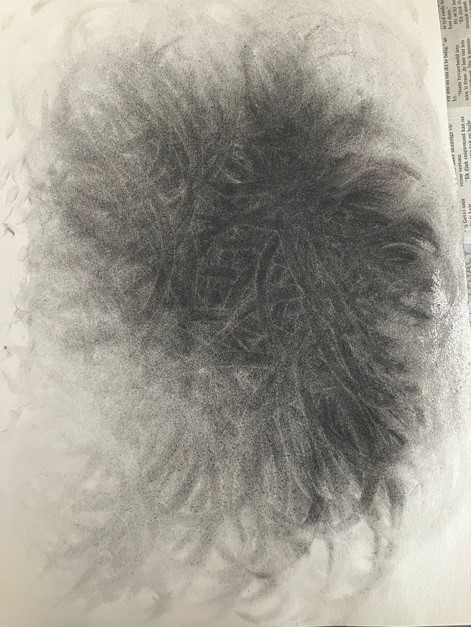
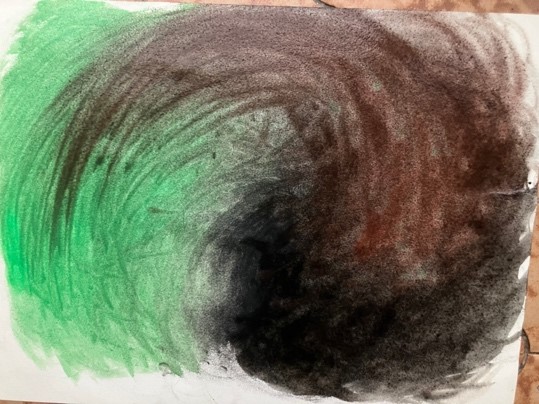

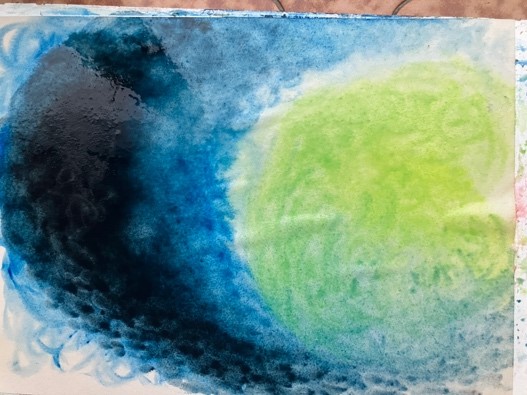



4. Matter and spirit, and the concomitant presence of emotion in your performances have been a theme in the materially discursive and practical application of your process towards ABJECT. Could you say more about this?
Imagine that everything you look at was once a thought – in spirit, invisible, unseen – which then materialized in matter. For instance, once an idea, it became a table. This is the principle I work from in Genre too. My thoughts and feelings will create a movement, and at best I would be able and willing to link these through experience. I remain diligent about this principle and it affords me an infinity of possibilities. In turn, of course, movement creates ideas. But rather than having a linear back-and-forth way of understanding this principle, I would like to offer another image if you wish.
As a gardener I have been trained that plants do not only grow upwards because their roots are at the bottom. Many other processes could be seen to be working from the air inwards of the plant. You may see this as the atmosphere surrounding the planet filled with myriads of elements such as nitrogen, carbon, oxygen, hydrogen and so forth. These could be seen as the unseen “spirit” that nourishes the “matter” of the plant, in addition to the nourishing gained from the equally unseen spirit of soil and water elements. But spirit is actually everywhere amongst the matter. Spirit, is the plant matter itself. And vice versa. Vibrant space is in things themselves.
How one works with this principle in dance may be varied depending on the purpose of the investigation. For a start, bodymind praxis, such as Genre, entails thought as an embodied phenomenon. But there is passive and active thought. One thinks passively, by always responding to what the world offers you. Social media’s incessant flickering of visual images endangers the individual’s ability to create active thought, as it is mostly in reaction to what exists already. Enslaved thought, it could be called. On the contrary, when you write, create an essay, or produce an idea from the self, without any obvious impulse from outside, this is active thought, a particular enactment of the will ¬– from gross to subtle. An understanding of the human will as a weaving of matter (things) and spirit (thought) in intricate ways to bring about an experience in the self, effects the thinking and psycho-spiritual becoming of the individual, through writing, in this case.
The human will, can be practiced as movement of thought – subtle as well as engaged in large arrays. We do this naturally, anyway. But in dance you enhance the clarification of the will through what your body becomes as a result of the will being moved, known and loved. I would like to mention here that, when in practice, this range-wide ability increases with age, becomes refined and endowed with specific aesthetic realms that may or may not be known to the dancer. Note that this practice is not something to expect from a young dancer. A young mover has the right to the joyous freedom of movement without thought being interspersed in the vibrant act of movement. However, an embodied teacher is an incredibly valuable person because the child directly models and forms herself on her teacher. Much about training for dance teachers can be inclusive of this conversation.
This engagement of spirit/matter through the mediation of the will – as dance – also brings light, a light that shines up within every time a new insight is born, and can be born through this way of working with movement.
In addition, the emotional body enters this bodymind as an in-woven feeling evoked through thought-movement, evoked through the human will. And vice versa. Here thought gains a flowing movement like water and the breath, voice and muscle tone configures to shape emotional content. Now the conscious world of dance makes space for subconscious activation with an increase of feeling, accompanying physical sensations.
It is again important to know that the psyche wants stability of experience at all times. And the emotional body will often have to shut down when the thinking body with its spirit/matter configuration shifts emotional content into unacceptable ways for specific human integrity of being.
It is here where one needs a solid technical experience of how an emotion needs physicality of a particular configuration for that emotion to be legitimized as an experience of emotional honesty and psychological integrity. For instance, an infant cries with a sense of tremendous power, from an observer’s point of view, with a taut body and strength of muscle that is almost unthinkable. This is when one realises that we learn to flow like water and become solid in the thinking, willing and feeling body. When an emotion is expressed with an authentic thought and will, we are directly engaged in the potential creation of mental health. It is vital to know that this expression has no bounds to the voice, which, as sound, also creates movement in the air.
When someone expresses having difficulties with feelings, this is a complex statement. Since the beginning of my training in movement therapy I was aware of how the physical body has to sustain the contours of emotions with rigorous precision in order to sustain a particular configuration of mental health. In the world of suppression and oppression, and the personal repression of emotions for various fears of exposure – culturally, politically, mentally and spiritually – the art of knowing how to embody feelings is equally rigorous and needs to be approached with great care and concern. Entry into this practice as therapy happens when a person could be largely out of touch with emotional content and feels the inappropriate embodiment of emotions threatening the coherency of personhood. This is why active thinking accompanies emotional embodiment.
In ABJECT this practice is further enhanced through an exploration of aesthetic choices by the humanity of the dancer, that make this an artform so authentically human that I could only call it Genre, the ensoulment of the thinking body.
One could say that one initiates oneself through this work in ways that award one with a wisdom born from within that is stable and trustworthy. But what needs to be known here is that this award is primarily one of love. The love one gains for the self could be placed at the forefront of this investigation, and when this love is absent the journey is long and often marked with interrupted bouts of doubt that one is on the right path. Yet, strangely, like wisdom, this love for the larger self, once emotional content is authentically embodied, is stable, reliable and a strong source of personal integrity. Somewhere between a primal wisdom and love one feels towards the self, a particular appreciation for the will in which one feels one has an inherent capability for, is the gift of self-trust.
Even though this work is everybody’s birthright, a deeply penetrating will to change oneself to align with a sense of soul and spirit emerges as a path to enter onto.
5. Could you discuss how you think and work creatively with the elements of the white clay during ABJECT?
Since 1986 I have incorporated kaolin clay into my performances, always applying it to my body and specifically my face and head. In the first performance of Timeless Tango, I traversed the animal and human in the hunt to the demise of both. See the archived exposition here: Timeless Tango
In ABJECT the traversal of these spaces has multiplied exponentially. The initial application of the clay on my legs, arms, upper body, face and head, in that order, is a gradual approach of the human consciousness with an increase in the concomitant presence of abjection. One may become many manifestations for witnesses, but many Other manifestations emerge for the performer. Multiply the visions of witnesses and their potential experience of the abject with the performer’s multiplication of abject into more and more emerging manifestations of consciousness. This could be an example of clay on the human face, being engulfed by a potential suffocation and oppression of this substance, a crisis of identity, existence, ecological fusion and potential spiritual ascendency.
The cultural application of clay on the body and face can be found globally, anywhere from Africa to Japan and elsewhere in indigenous practices where the individual traverses realms of consciousness. It signifies a transition from one cultural, psychological and spiritual realm to another, mostly in ascendency of significance. But becoming animal through a mask is a transcendence practiced by cultures that heightens the humanity of a people. The ability to “step over” the human condition into another world brings enormous cultural presence accompanied by spiritual qualities such as courage, exuberance, states not normally invited in everyday activities, yet vital for the deepening of personhood, ethnocentrically or spiritually. As such, this practice is engulfed in the abject, the more-than humanity.
For ABJECT I dig up kaolin on the land of the videographer of this performance, Kali van der Merwe. These hard clusters of clay may withstand weather, but crumble quickly to powder when broken by hand.


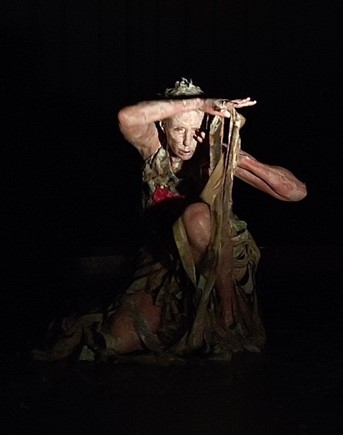
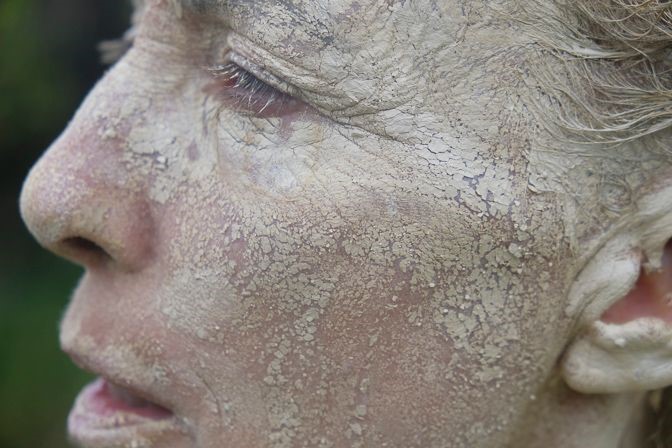
In ABJECT this transcendency through wet clay and movement, skin sensation of gliding touch and floor movement and the multiplicity of images steering my dance often traverse the human and more-than-human territories into infinite possibilities of being human, or humanity. Humanity as an entity with many possibilities, and as potentially disappearing from the epoch of our planetary time. As performance the humanity emitted from one individual represented in each witness as many more, and more-than-humanity within the intelligibility of everything surrounding the performance – from atomistic to wars affecting our ways of being as humanity and more-than-humanity ¬– the clayed emission through authentically willed movement, offers an irreducible humanity never to be predictable, repeatable, or controllable – because the earth (clay) is exactly thus.
Lastly, the effect of white clay drying, forming marks and powder on the body and theatre stage, and a very light velvety sheen on skin, is an experience – visually or viscerally – of a new born child’s vernix, a white, creamy, biofilm rich in nutrients and protective substances for the birth process. For almost 40 years this viscerality has accompanied me, affording a direct experience of self-initiation with every performance. In the light of insufficient or lacking cultural rituals of initiation, this device – white clay – afforded me a multiplicity of complex cultural experiences – self-initiated and spiritually enriched – through performance.
6. How did you make choices regarding your costume for ABJECT?
For the aesthetic presentation of abject, a costume could absolutely be anything. After all, the endless absorption of an irreducible humanity is not capturable.
When I realised that this performance would have an existence in a few months’ time, the first image that came to me was the two red squares placed on my chest and back in directly aligned spots so that one act through my being would pierce both squares precisely. But the image of the red square emerged as more than that first impulse.
Weaving represents women’s work, for me. The act of crossing, and recovering, emerging and disappearing with mathematical acuity and attention gradually thickening a texture with inexplicit yet densifying devotion, wisdom and love is a cultural, psychological and spiritual phenomenon, often mysterious for those who do not penetrate this practice. It is enigmatic and can be enchanting.
To meet the abject, I found a piece of brown canvas four meters long. I did not want to revert to abject as repulsive and therefore chose a dark colour, or earth, which we call “dirt” in a casual way. Soil is the kingdom of life and the sooner we tread and treat it as such, the better for humankind, and the more-than us. So, the idea of colour but carefully chosen colour entered along with the brown fabric.
I painted one half of the fabric and began to cut it all into strips. Onto a neutral piece serving as lining, I began to construct the weaving from the top to the bottom of the costume. I found the weaving process to be immensely satisfying in a mathematical, thought, visual, kinesthetic and visionary way. There was something deeply erotic in the diagonal precision across the body of the costume. It aligned itself with ease of eye and hand movement. The strips were very long and I figured that there might come a time when they would be cut. At each intersection the weaving mechanism had to be sewed, so each crossing times four. As soon as the bodice reached some substance, I cut out the two red squares and pinned them on. I could see the necessity of this feature, yet without a performance in the costume its significance would not emerge for me as yet.
When I embodied the costumed contrast between the weaving and the squares, the stark contrast completed the experience of the costume for me. The one feature could not exist without the other. Upon the feminine act of weaving around a feminine body, the patriarchally emboldened symbol of the red square problematised the weaving’s total autonomy. Yet the infinity of the loosened weaving, chaotically entangled around my legs and feet (and arms during some parts of the performance) brought in a crisis of devastation in my movement and voice execution. But then a third element came in. When I applied the white clay and it spilled over my flesh and costume, over the weaving and the red squares with a sheer and glaring abject the costume came into her true existential purpose: an irreducible humanity.
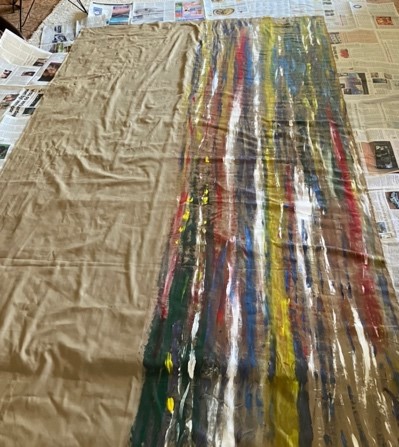
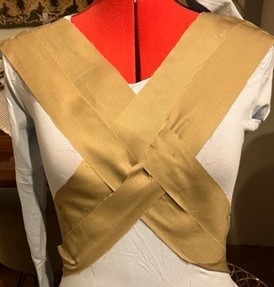


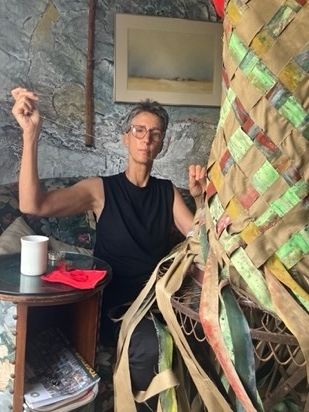
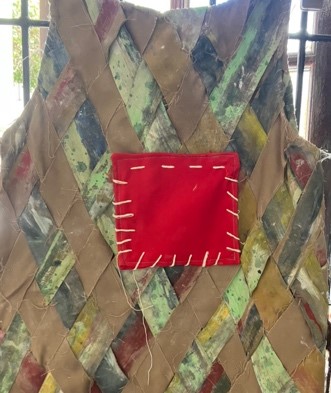

7. Your interest in feminist, new materialism underpins a major tenet in your work. Could you speak about it?
The new materialist and feminist undergird of my work is paramount to my philosophical approach to movement. Let me give an explanation.
Over the past 400 years and increasingly so during this century, the way of seeing and treating matter has taken a steep curve upwards, in line with the devastations of climate change, food insecurity, obscene escalations in capitalism’s brutality on land, seas and air, and social issues such as youth unemployment, weakened educational progress with its concomitant dehumanisation and destruction of our environment all over the world. This tremendously densifying tendency has also had its effect on the human body. And where the human body is foregrounded, such as in dance, this tendency towards a physical exceptionalism with higher and wider, and faster temptations fulfilling youthful desires to be recognised for their extremities, the human bodymind and humanity is in fact, sacrificed. With it, the in-feeling of what the soul is here for, and, the human spirituality has also been sacrificed. What we teach and model as dance, need to be thought of deeply enough as serving the human being more holistically.
The wisdom and love – the wise love; the loving wisdom – with which we regard ourselves as matter, soul and spirit is often only available in the more mature and ageing dancer if the willingness to want this knowledge is present. The tragedy of the mechanised dancing body lies in its hardening of forces, hardening into the bones and muscles, organs and brain for the sake of the athleticism, power, exuberance and often injuries to the bodymind that may affect the dancer for years to come.
How would this be different if we see our materiality – the matter that we are within space and time – with an intelligibility that could also be understood as the actuality of an environment that we take for granted? What would it take to overturn 400 years’ exploitation and hardening of matter, emotions, intellect and spirit into rapid and hardened form – versus staying with matter – and to recover a more humanised body through a different training and philosophy?
With the realism of world changes having come very close to each and every one of us, the alternative approach to dance training can bring quite a radical trajectory into the environmental and political philosophies we engage ourselves in nowadays. Matter which used to be seen for its functional purpose, from minerals to animals, soils, skies, weather, rivers, edibles, water and plant-life has lurched into a more-than human “protest”. We see countries transforming when the ices melt, landmasses disappear, storms change entire geographies, fires obliterating farmland and human-inhabited settlements, not to speak of toxicities turning fertile and living ground into death. Partly, the human influence, the Anthropocene can be held responsible for this. The manner in which we have understood matter – functionally – without investigating our own sensibility towards matter for the purpose of our own evolving intelligibility – as matter – has separated us from our world, and from a sentient possibility in our becoming.
I argue that the potential to be connected to matter has traditionally and ontologically been more obvious to the female body than the male. The female body experiences alterations of the matter that we are made of – bodymindly – in a far greater, troubling, way. Women rhythmically enact imminent maturations through blood, changes in the bodymind, weakening of bones without minerals after giving birth, hormonal disruptions, maternal and spiritual exhaustion and pathologies of the feminine constitution. We know matter through our beings in ways males may not experience or take notice of in women.
Feminists have studied human subjectivity – sexed specifically – and the sculptural, cultural effects of this phenomenon extensively. There is nothing neutral about being female. From our own blood to the pollution of toxic waste, the war, and the undrinkable water, we have a lived experience of the culture of things – matter – through our experience of them. For women, neutrality is not a place outside or inside of ourselves. Julie Kristeva’s banner quote still remains: powerless outside, impossible inside. We recognise the wholly unspoken agency or other-than-human forces as influencing us always, already and automatically.
Moreover, women recognise this realism that calls attention to the myriad ecological, biological, and physical processes that have no business with the manner in which human knowledge has categorised them. Most life is non-human. Yet, women understand the absence of these life forces – vivacious and vulnerable – and their effects on human living intrinsically – and anxiously. But what women do understand is: unneutral, we do belong to this world, the one that increasingly turns in ways unknown to us.
One of the chronic and incessant realisations of feminism is that we witness skewed knowledge being constituted as statutes upon which civilisations are being built. The disconnect between our lost ontology with our material world and the prominent knowledge we manufacture upon that loss, is demonstrated in incompetence, and iterated hardening of ideologies, technologies, with for instance, short-lived gains such as agricultural use of soil- and air-deadening substances for the production of food. This knowledge is limited to human knowers with very little embodied experience of the relationality between things, relationships before things relate, the fact that relationships have been there first as imminent entities of health and well-being before human thought separated its elements. The new materialist feminists allege that ideas and things are not separate orders but are co-constituents of making the real more real.
The hoariest, most worn-out of philosophical binaries is the form/matter distinction. In ABJECT I would like to think that one cannot put a finger on the one matter of my dance to prove its existence. Note that I do not use the term “form”, but rather “matter” here. I do not dance to create a form of meaning. On the contrary, in honour of the matter of bodymind and my investigation of the abject in this case I do not consider the dance as separate from my experience of my mattering at any moment. I access my own material liveliness, whether it moves or not (for) the witness. It is here where I side with writers like Jane Bennett in her book Vibrant Matter9 and show up for art as that: vibrant matter. I acknowledge the will and life forces that the artists engage in to embody what is currently the matter in the bodymind.10 It is in this practice, that the movement of the performer mutates and emerges into matter, that is often new and unfamiliar, uncanny, disruptive, unsettling and unknown to the dance. Yet the dance, inherently a phenomenon that does not exist in the ambivalent binary, does exist in the abject, born from the human struggle with ambivalence, the result of the collapsed binary of subject/object. This abject is discontinuous, queer, displaced, identity-less, refusing form which can be objectified, but enlivens matter, as in feminist new materialism. Think of humanity not as a wound-up toy, but one that has attained its honesty as matter. Parallel to this, in the patriarchy, being a body is not a smooth systematised business, nor can we go without bodiliness. abject may begin to make sense as intelligible performativity of this matter before separation from itself; and, as abject entangled in the patriarchy as that irreducible humanity we strive for. Yet irrevocably, like nature, we cannot pre-exist our construction. Doomed and celebrated as abject.
Not being able to put a finger on my dance – almost like the quantum effect of knowing its existence in many places and temporalities – also means that it has no name. And therefore is not representative. Language (with its excess powers) simply provides a positivistic label to make inscrutable cultural and psychological “sense” in a shifting context and temporality, erased at once. Even the materialising effects of this performance discourse adds to the irreducible humanity in an ongoing entanglement, yet erases itself from such a form.
A week after having attended the performance of ABJECT a female acquaintance said that the performance is still having a visceral effect upon her brain. This she said, while attempting to illustrate it with her two hands “vibrating” facing each other in the shape of her head in front of her. I observed this gesture and in the rapid amplitudinal back-and-forth I sensed each motion a slightly different one each time. One could say that this ontology was the emergent feature of entangled phenomena that may have been there before her attendance of the performance. That her relationship with the performance therefore existed before she arrived. That there has never been a duality, a binary between herself and the performance. That the manner (through her embodied gesture) in which she has become was actually available to her all the time. Her gesture, in all authenticity, “should” never be otherwise.
For feminist new materialism, the solution to women’s historical assimilation with nature, matter, earth, and origin – the problem that led social constructionist feminism to culture - is to sidestep the essentially ideological use of these terms. The actual world is instead rich, strange, and as transformative for our understandings of sex and gender as it is for our conception of time, space, matter, and individuality. The human body is the site where science and art intra-act.11
As I hope to have demonstrated, it is in fact difficult to find a moment in feminist science studies when questions of female embodiment, nature, science, realism, and referentiality were not explicitly at stake, yet erased at the same time. We are still at the beginning of discovering the generative potential of human assimilation with matter, outside of cultural constructionism. But it is clear that the field is greater than the sum of its parts, and possibly trans-personal, thinking the non-human provocatively unknowing.
ABJECT – humbly immersed as vibrant matter, erased generatively.
You cannot speak into abject with absolute accuracy as a person undergoing, undermining, overmining with a linguistic sculpting as if it is an eternal form. It can also not be representing anything known to the human because so much of itself is non-human always, – already having assimilated the world – and , one could say, it is vacuum-sealed against the exclusive human realm. The dance’s being (beyond the dancer) does not bear on its meaning, or vice versa.
In the act of dance – the matter of dance – no duality or entanglement ever penetrates deeply enough. One can always move further even if one employs technical devices such as breath, voice, micro movement ... always open to being-becoming’s conditionality. In/as language we could imagine it as the chora13, the infinite receptacle, or womb – neither being nor becoming, unsexed, matter, beyond systems.
Bennett calls her approach a “vital materialism” and defines it as an attempt to “dissipate the onto-theological binaries of life/ matter, human/animal, will/determination and organic/inorganic” (VM, x) in order “to enhance receptivity to the impersonal life that surrounds us and infuses us” (VM, 4).14 As performative authentic spacetimemattering this is evident in ABJECT in a human/non-human entangled enactment in this video, which has an accompanying description below the YouTube video:
My eyes see without looking...
Go not to the object; let it come to you.
Henry Thoreau The Journal of Henry David Thoreau
It is never we who affirm or deny something of a thing;
It is the thing itself that affirms or denies something of itself in us.
Baruch Spinoza Short Treatise II
9. Jane Bennett Vibrant Matter: a political ecology of things. 2010. Duke University Press USA.
10. Notice how we have constructed our language to ask a person: “What is the matter?” when the person appears unwell, or troubled.
11. “Intra-act” is a Karen Barad, feminist quantum physicist, term that acknowledges not two units that “interact” but a relationship that exists before separate parts are known in highly complex configurations.
12. Donna Haraway Staying with the Trouble Duke University 2016. p. 104
13. See a further discussion on chora in question 10 on authenticity.
14. In Vibrant Matter: a political ecology of things Jane Bennett pursues “(1) [...] a positive ontology of vibrant matter, which stretches received concepts of agency, action, and freedom sometimes to the breaking point;
(2) to dissipate the onto-theological binaries of life/matter, human/animal, will/determination, and organic/inorganic using arguments and other rhetorical means to induce in human bodies and aesthetic-affective openness to material vitality; and
(3) to sketch a style of political analysis that can better account for the contributions of nonhuman actants[.]” 2010. Duke University Press.
8. What information would your witnesses need in attending a performance?
It is important to know that I do not use the word “audience” (people who come to listen), or “spectators” (people who come to watch), but “witnesses” to be the persons who chose to come to my performances with multiple senses and intelligibilities. More about this later on.
As mentioned before, my theatre space is relatively longstanding at Theatre Arts in Cape Town. It brings a steady intergenerational witness body that I have noticed over almost two decades. However, new witnesses enter the theatre regularly and I have often grappled with the idea that witnesses need to be informed as to how to be present in Genre, the methodology of performance I practice and study. As one would class Genre as embodied research, surely the embodiment of the witnesses also needs to be researched?
Seldom, if at all, is it the ethical praxis of a performer to “tell” the witnesses what the performance is all about, or, more, how they ought to perceive the performance. Performance, like writing, is to “show” rather than “tell.” This is to preserve the right for the witness to form and substantiate their own unfolding through their experience of presence and witnessing participation. At most, my works have titles. But like ABJECT ~ An Irreducible Humanity it could just as well have been the title of a book. It nevertheless remains enigmatic, in my view, and should be thus.
In theatre, witnesses arrive with a sense of excitement, an already open will to be present. I wish to consider theatre from a primally spiritual way of being. After all, historically, since ancient times it was a place of communal and ritual transformation far more than that of pure entertainment. A collective indigenous body’s survival may depend on the quality of the witnessing. A body politic may be at stake and the quality and ethic of beholding the performance may culminate in a tribal decision of profound proportions. These are the impulses whereby I regard a witnessing body during my performances.
Further, the witness is the lover of the performer, the beloved. They witness because they love the performer and are willing to be present to behold the distinction for which the performer has prepared herself, and, for their sake – their transformation. This precondition already shapes the perceptionality configured in the witness in order for the witness to gain the wealth of knowing and experience that the performer offers.
Needless to say, for a person familiar with the traditions of theatre based on the Western and mostly colonial style, or one who has experienced theatre in a village context and where the performance could take on a ritual or shamanistic format, Genre could offer a distinctive introduction.
The affinity that I assume between myself and the witnesses and the love that opens up the channel for wisdom and transformation, is available for all of us. I also assume that the love for the beloved performer has a wide embrace for what the performer has come to deliver. This assumption includes myriad complexities and even complications for both the performer and a witness should the manner in which they are prepared not to assume complete and easy acceptance of material delivered on stage. My work could be perturbing and at the same time largely affirming. I have always considered this the ideal scale for the “appropriateness” of the work I deliver. I do not entertain, and I do not confirm what exists already. My manner of embodying an authentic state as response to the world is a template of humanity and a momentary ontology against which witnesses momentarily evaluate their own ontology and adjust their comprehension thereof to make meaning out of what they had experienced. This is a very fresh and unusually edge-like experience amongst all of our bodyminds.
When someone asks me how my performance went, it would be like asking the wave how the event of its journey to the shore went. There is no intelligent answer and the next wave is there already. It is when the wave recognises itself as the ocean, that we realise that intelligibility in everything is a responsiveness to what matters. Intelligibility is a vibrant connectivity with everything that matters.
With the nature of this thought, a witness may experience a very different performance from one who is looking for a story with a beginning, middle and end. I would like a witnessing member to allow me to dance for them, as if I dance that which they cannot, will not or may not, should not, and cannot afford to dance themselves. With this they may sustain that generosity of allowance that may be transformative, enlightening, insightful, visionary, imaginative and inspirational. But let us be clear that the abject is ever present in all of us. And if I embody the abject with a particular aesthetic, a configuration of costume, clay, facial and bodily expression, the unusual movement vocabulary, dissolving breath and voice, then that too is the undercurrents of our humanity – and it will be embodied without hesitation.
It would be important for witnesses to “stay”15 with their experience and not compare (and even fight!) about whose interpretation of the work is most truthful. I require liberal autonomy of experience from my witnesses as much as I require this from a witnessing gathering. It is a requirement of being resilient in a fearlessness of perception, an allowing of the self to roam free and for the length of the performance to allow a different light to emerge from our sensing and thinking as a humanity in perpetual crisis. Of course, as part of that maturity we are all responsible for what we experience in a performance.
15. Similarly, Donna Haraway suggests this in her book Staying with the Trouble. Refiguring “our current epoch, moving away from the Anthropocene toward the Chthulucene: an epoch in which we stay with the trouble of living and dying on a damaged earth while living with and understanding the nonhuman in complex ways conducive to building more livable futures.” 2016 Duke University Press.
9. You consider theatre to be a space of imminent love that affords your performance work. Could you expand upon this notion?
Yes. I wish I had thought of spaces and performance in this way earlier in my life. You may want to think of it as one of many spiritual containers of my current performance art work.
First, the matter of this space – Theatre Arts in Observatory, Cape Town – has been a home for my work for almost two decades now. This physical space – an architectural soul of openness to my work – is simple, fluid, friendly, inclusive, courageous and available. This is rare. Caroline Calburn is largely responsible for the creation of an independent space, free of politics and hierarchies and unnecessary pressures that performers can do without. Theatre Arts is a spatiality that has offered performers an incredible launching pad for their drives to give form to themselves and enrich witnesses with their theatrical endeavors, especially young theatre-makers. I feel loved by this space and this has grown into a spatial entity with a sense of spirituality that calibrates with me.
Theatre Arts is also the space where I can develop the notion of performance not only as a concept that will be created by me, or other performers. I feel the space as having a worldly sacredness – if you could imagine a temple, or altar, or ritual space. But more than the physical entity, I am aware of the kind of work that I do there, and how I can and may bring myself there. So, over the years I have developed a sense that Theatre Arts is the space full of spirits, ancestors, angels, gods, you name it. I seem to get this when I perform – a created privilege of note.
But let me go to performance as such, the entity, the body artistic – another inspired concept – the love that affords me a becoming. Performance is the spirit witnessing the work I do with interest, attention, and love.
So far, we have used the word “performance” as a noun, an adjective or “perform” as a verb. Now imagine “performance” as the embodiment of the benevolent parent whom we have desired all our lives. This figure within beholds all the acts of the performer’s self-expression with fondness and loving expectation for what may come. There is never any judgement or acts from this figure that create guilt or shame in the performer. This is a loving presence, witnessing the performer unconditionally, and willingly allowing for the space of acceptance of anything the performer wishes to express about themselves. Performance is the kind and compassionate witness into which the performer “pours” everything. And then the performer has an experience of being seen for the first time – a primal experience of being well with all and everything, as abject. Even if the performance is a response to the most abject possible, or if the performer becomes the abject beyond imagination she can muster, performance makes it all acceptable, welcome.
If this is a view of performance, then everybody who reaches for performance reaches for a most primal state of being, being loved unconditionally with the most abject of being.
Now you will understand why the witness is the lover of the beloved, the performer. They are both in the arms of the mother of love: performance.
10. Authenticity of being-and-becoming within the abject has been a strong component to your performances. How do you speak into it?
It is a philosophical imperative to research the two states, being and becoming, in order to problematise the phenomenon of embodied authenticity. One also need to have an affinity to explore space, time and the matter one is-and-becomes within this most complex yet embodiable phenomenon called spacetimemattering, a term by feminist quantum physicist, Karen Barad.
Being has been a contentious item in how we see and experience the world. Women’s being, for instance, their psycho-social and spiritual construction, has afforded the world with a stereotype – a being – that has inflicted enormous pain, disharmony, criminality, femicide over the ages, a socio-political fate which has not even begun to be investigated apart from feminist scrutinization of inequality on many levels. The same with homosexuality, the otherly abled, the dyke, the person born in a place where the earth is so saturated by toxic waste that they cannot help but attract leukemia, the young woman who has to conduct her own abortion, the young child with a dying child in their small arms in the rubble of war, the eternally unemployed, the deported, the rape survivor, the civil disobedient who cannot mind the world without drugs, a worker who sustains a nation’s economy on their backbone vertebrae bending under bags of weight. These are all embodiments of being. This is the nature of being. There is no law of nature. Nature is a construction. For most people, this being is a state that they cannot see a becoming out of.
This leads to a term we call representationism. The manner of being is also the manner in which one represents the fact of one’s being. Whiteness will not change while our manner of representationism is cemented into our own being, which informs the manner in which we observe a White person – pre-colonially, colonially, post-colonially and neo-colonially. The White person represents a conglomerate of perceptions just as a female body represents the possibility of sexism, or an effeminate male represents the possibility of homophobia. In short, our way of seeing informs our way of being. Language (of being) is constantly being constructed around this being to cement it into our thinking, where it is the most difficult to change. We could also say that being has been given “form” and has been abducted from its “matter”. More about this later on.
Being could also be better understood as “place” or “space”, a situatedness towards which we could point a finger for certainty.
Becoming has a dynamism to it. Where being afforded us “space”, becoming afford us a sense of “time”. One cannot pin this thing down, to observe its movement, the devil is in its weaving, entanglement, eternal unfolding, incessant relationality, incomprehensible rhythms, unrecognisable sounds, potential terror and unknown territories of the bardo between death and life and death again. Explosions happen on micro and macroscales. Everything is potentiated with the unknown, and in the human psyche this evokes a phenomenon called the abject in no uncertain terms. Our sentiments of the creative, inventive, explorative, terms we bandy about with abandon, inherently embody the abject, the potential for danger, a becoming that can obliterate the human race as in the case of nuclear war.
What will it mean to the human race if we stop taking for granted that we all mean the same thing when ideas are transmitted?
With this question I hope to freeze the incessancy of both being and becoming and invite in a third term which I encountered first from my reading of feminist philosopher Julia Kristeva, but subsequently discovered it as having been given birth by a male, Plato.
In Plato’s Timaeus, as in my own experience as movement researcher, the bodymind of the mover is constantly enfolding, in-folding, being folded into and under by a third term which I could embody as an almost positivistic outcome, yet one that I can authentically relate to as a mother. The chora is Plato’s uneasy third term, unsmooth and yet cannot go without.16 It therefore, I argue, has performativity. Of itself, a both being-becoming with an agentiality of life-giving will, the chora is the matter, the materiality of movement itself. There are no parts, it persists at all cost, it does not tolerate division such as object and subject, has no limitations, is living matter at all times, as matter, more than form and is a space that dynamises – a dynamised space. One could say that the chora breaks into the sloth of easy and lazy separation because the dynamism cannot be sustained.
I experience the chora as the timeless “womb” or “receptacle” without veering towards being alone. It is transition of a kind that deeply acknowledges its own depth and generativity, disrupting the duality of being and becoming as separated, yet not being faithful to neither. Timaeus speaks of the “wandering cause” (48C) that holds and disrupts movement at once. The chora is not domesticisable (like an engine).
In the video clip I offer here, Genre as performance offers an authentic embodiment with certain features each to be discussed not without the other. Both the entry into the chora is a smooth and quite “obvious” settling for the chora to be performed. Once the foot and hand, after a journey towards each other, found each other, the chora as Kristeva applied it to the infant’s earliest, pre-linguistic, psychosexual development with a chaotic mix of perceptions, feelings, affects and needs, set in. While the rest of my body sustained a condition for the foot-hand movement to experience the “womb” of the chora, my whole body, the floor underneath me, the theatre space, the musician, the sounds from his cello ... became the chora of this movement. Within it all I left being a dancer, a woman, a dress, a dance, a reality, a knowledgeability and a representationability.
At best, this is an intelligibility of authentic performance, an ethic with an authentic aesthetic which could be studied for its immersion into the chora. The experience embodied the more-than principle in the irreducible humanity that replicates the more-than existence of the more-than humanity of this epoch of liveliness. As such it offers an aesthetic-political milieu to begin to propose a different structure of understanding a different “law of nature” from which we could not reduce humanity.
16. Plato, Timaeus, ed. Oskar Piest, trans. Francis Cornford. New York: Macmillan, 1959
11. How did you incorporate other people in the production of ABJECT?
Caroline Calburn is the theatre director of Theatre Arts. She has been a witness of my work for close to two decades. When I sense the emergence of a performance, I immediately contact Caroline and we make a date. Her formality is ensconced in a personal democracy and appreciation of my work for which I will always feel highly grateful.
Frans Mandilakhe is the venue manager and lighting operator for Theatre Arts. For many years Frans has acted as a lighting improvisor for my work. In other words, he intuits the movement and messages ahead of real-time and creates a lighting accompaniment for the performance. I cannot emphasise the value of such technical support enough for the aesthetic template into which I can deliver my dance.
During 2013 I taught and witnessed the actress Jennifer Steyn in this work which we call Genre, on a weekly basis over ten months. Jennifer lives around the corner. We call each other when we call for Genre, and we act as witnesses for the embodiment of what is present, unclear, unarticulated, or even strikingly front of mind and difficult to live with.
Kali van der Merwe is an artist whose photography is deeply contemplated with an ecological ethic that rips through one’s determinate perceptions of the nature of humanity and the beyond in its forms of the animate, and the animate human body. It is through Kali’s photography of my performances that I manage to study, penetrate and escalate the value of this work and its edges of the un/known.
From the start of this performance operation, I contacted another neighbour, Carey Yarrow. Once Carey knew what my vision was, she held me to it in the construction of my costume. It was a particularly privileged position to be in to discuss my next moves in the painting, cutting and sewing of the strips that would finally weave my body into lanes of brown and other colour. Her instinctive grip on the meaning of the red squares, and again holding me to it, was a sign of a true mediator for my vision to materialize itself, ultimately through performance.
Another neighbour, Erla Venter, an elderly friend, was prepared to open her door with me walking in with an arm full of fabric, roll it out on her floor and look at her in unknowingness. It was this quality of friendship that I relied upon as the basis for many other facets of the work, for which my fortunes are immeasurable.
A long-standing friendship with John Cartwright accompanied me over the two months during which I could discuss the latest, and often disturbing facets of the reality of performing my bodymind, with the realisation of its effects on witnesses who would be unaware of the more profound aspects of what this work might have on them. John is a calm and considered listener and proofreader of my writing.
Ralph Yarrow is a fellow theatre-maker and elder. Conversations with Ralph about the confluence between elderhood and performance have been a quiet and sane space of contemplation within a discipline of regularity and dignity for artistic work for the aged.
In the case of ROU2, a collaboration with a two-decade long friendship with cellist, Francois le Roux, I have had the opportunity to navigate various facets of two artists’ artistic and life impulses in real-time and theatrical space. The matter emerging from this collaboration always offers me a mirror to my own artistic development and the intricacies of a deeper listening and embodiment of who we are as souls in a dense process of creation. This collaboration is built on the trust inherent in the spirit of art.
People who come to my performances are outright exceptional in my view. They are brave and become braver as they enter through the Theatre Arts door again and again. My notion that audiences need support for what they are willingly open for has been a miraculous observational journey of experimental learning. I love every person who places themselves before this work.
